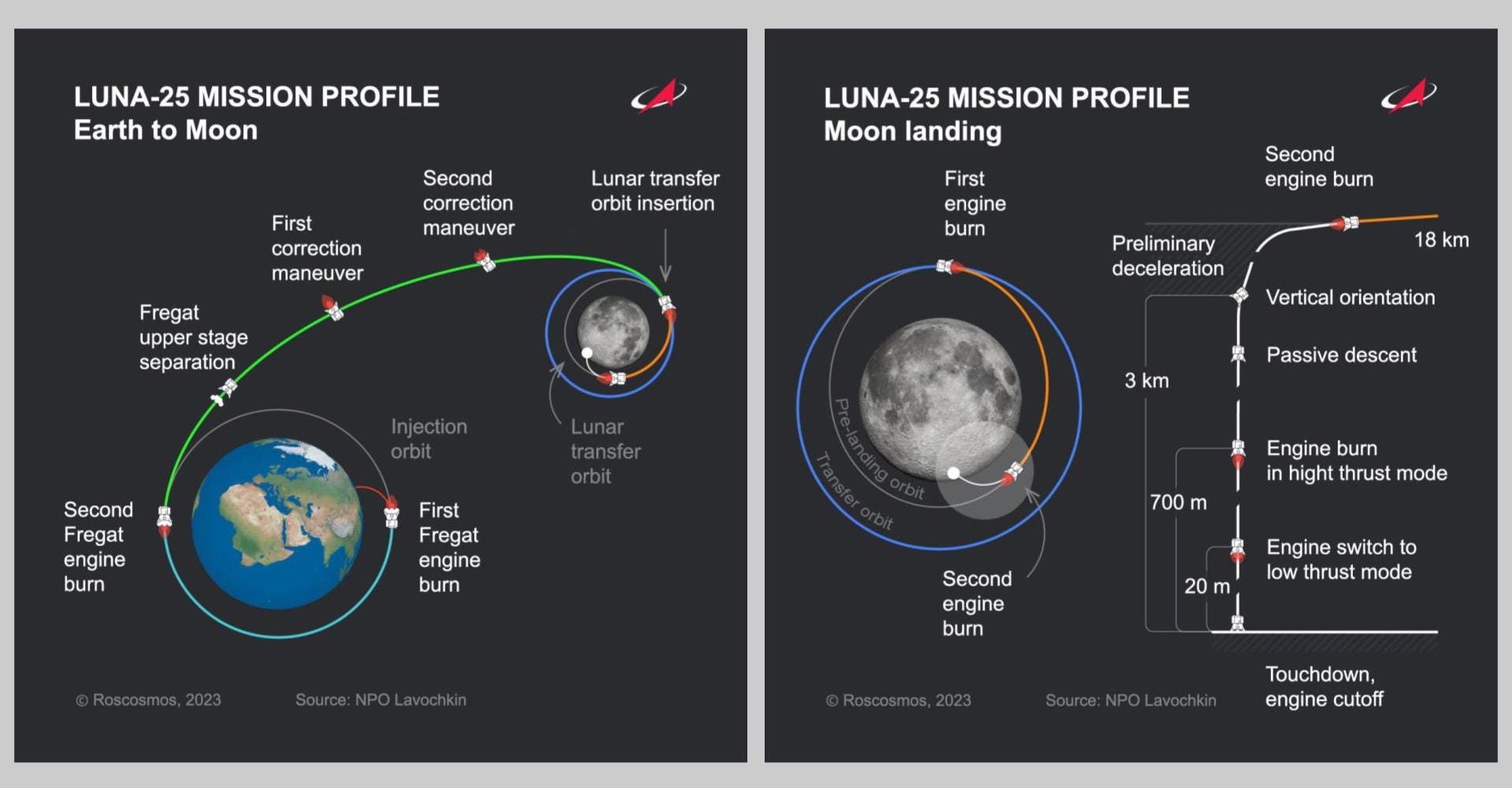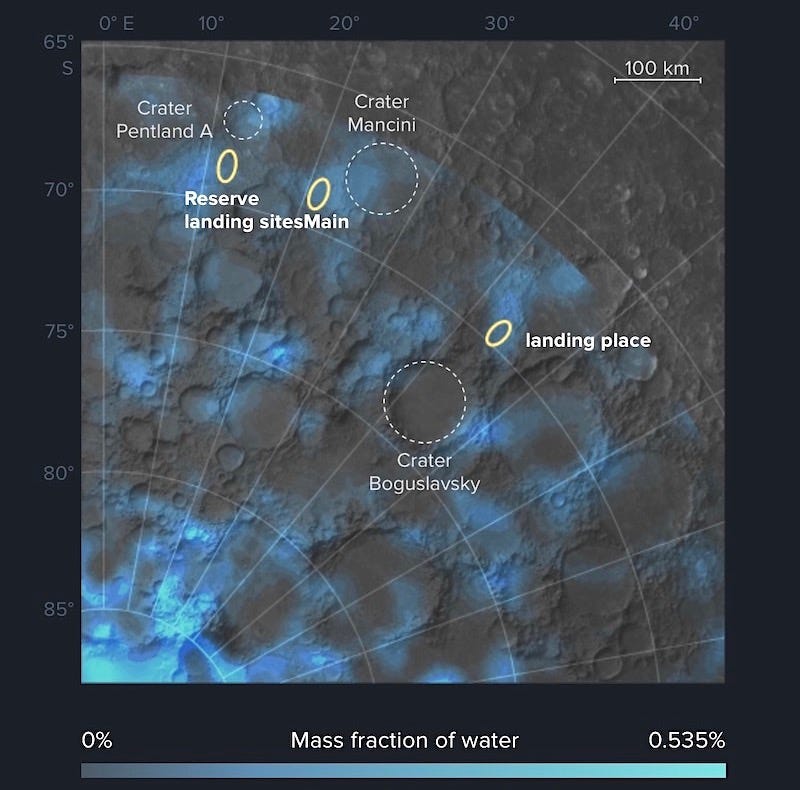Moon Monday #140: The Luna 25 lander and its non-race against Chandrayaan 3, and Artemis & CLPS mission updates
At long last, Luna 25 launches for the Moon

On August 11, a Russian Soyuz 2.1b rocket successfully launched the 1750-kilogram Luna 25 Moon lander, almost 47 years after the former Soviet Union returned lunar samples with Luna 24. The 3.2-meter tall Luna-25 spacecraft separated from Soyuz’s uppermost stage Fregat about 1 hour and 19 minutes post-launch. Fregat’s boost put Luna 25 on a trajectory to intercept with the Moon on August 16 for orbital insertion. As usual, Anatoly Zak has an great rundown on the specifics of the launch, deployment, and even the mission activities taking place.

Landing
If all goes to plan, Luna 25 will attempt a landing near the Moon’s south pole on August 21. As is the case with most modern lunar landing missions, Luna 25’s landing site selection process involved major input from NASA’s Lunar Reconnaissance Orbiter (LRO). While engineering constraints prevented the Luna 25 landing site from being truly polar, the primary site at 69.5°S, 43.5°E shows strong hints of subsurface water ice in existing orbital data, particularly from Russia’s LEND neutron detector onboard LRO. The same is true for the alternate landing site at 68.8°S, 21.2°E.

Six cameras on Luna 25—two at the bottom and four wide-angle ones at the top—will make a timelapse footage during the descent and landing on the Moon. The four wide-angle cameras will take panoramic views of the local surface. Luna 25’s eight instruments, which have a total mass of 30 kilograms, will study nearly every aspect of the local lunar environment—from the soil and subsurface to plasma and dust in the exosphere, including any presence of water across it all.
Russian media outlet TASS has made a really good, informative, and animated website on the technical and scientific specifics of the Luna 25 mission. The information is in Russian but browser translations seem to work pretty well:
Future plans
Roscosmos Director General Yury Borisov told TASS that the agency plans to launch the Luna 26 polar orbiter in 2027, the high-precision Luna 27 lander in 2028, and the Luna 28 sample return craft in 2030 or later. These missions, along with Luna 25, will contribute data towards planning of the China-led long-term scientific Moonbase at the Moon’s south pole called the International Lunar Research Station.
Is Luna 25 racing against Chandrayaan 3 for a Moon landing?
Given that India’s Chandrayaan 3 will attempt its lunar landing on August 23, and that Russia launched Luna 25 on August 11 seemingly out of the blue for an August 21 landing attempt, many people and media publications worldwide have boldly framed it as a race—notably without backing it up with due rationale. So, is Russia trying to beat India with Luna 25? In my opinion, no. That’s down to several reasons:
- This is not the cold war era. Budgets are finite enough to not risk expensive hardware being blown amid pursuits of trivial firsts and a slight edge at best.
- Luna 25 is delayed by many years to begin with. It’s only in the last two to three years that its development picked up pace. If we look at the mission preparation updates of Luna 25 and Chandrayaan 3, which I’ve been sharing for both missions here on Moon Monday, we know that Chandrayaan 3 and Luna 25 have been undergoing space environmental testing and final software tests for the past few months in parallel. As such, this overlap is hardly surprising. The specific dates are more of a coincidence than anything else.
- Luna 25’s primary landing site is about 100 kilometers east of Chandrayaan 3’s primary site. Lunar landings are typically planned to take place shortly after sunrise, primarily to maximize power generation during the lunar day. The landing sites for both missions were selected years ago. As such, if Luna 25 happened to launch in August, Russia has no choice but to attempt its landing on August 21 ideally, shortly after the lunar day dawns at its target site. August 22 or 23 serve as last options if the descent doesn’t commence on August 21 for any technical reasons. If this window is missed, Russia needs to wait in lunar orbit for a month before the same landing site can be within the lander’s range. This applies to India as well for the August 23–25 timeframe. If Russia really wanted to beat India, they would’ve scrambled for a launch last month to gain comfortable margins.
Let’s not introduce races, competition, and emotional friction in global discussions and outlook when there are no such things.
Many thanks to Epsilon3, Open Lunar Foundation and The Orbital Index for sponsoring this week’s Moon Monday.
New NASA Artemis developments

- On May 16, ULA attached a 0.6-meter, photosensitive anodized aluminum target to the company-provided second stage of NASA’s SLS rocket which will fly four astronauts around our Moon circa 2025 for the Artemis II mission. When in high Earth orbit, the Orion spacecraft will separate from the SLS second stage, and the astronauts will test Orion’s fine navigation and docking-related abilities with respect to this “auxiliary target” on the SLS second stage. The tests will aid future crewed Artemis missions, which will need to be regularly docking with lunar landers. ULA performed illumination testing of the target in May to ensure that it will be visible to the astronauts in space under varied lighting conditions.
- Delays caused by SpaceX’s overall failed first launch of its fully reusable Starship Super Heavy rocket coupled with the program’s many impending milestones has led NASA to consider flying a “different mission” for Artemis III with Starship instead of landing humans on our Moon mid-decade, Jeff Foust reports. The agency’s chief official for crewed deep space exploration, James Free, previously stated that NASA has delayed Lunar Starship’s critical design review until after SpaceX performs a cryogenic refueling demonstration in Earth orbit, which is critical to make the envisioned Starship Moon landings possible.
NASA CLPS mission updates

- Dan Andrews, Project Manager of NASA’s upcoming VIPER rover said that the mission team passed the agency’s gate review, which means they can now fully proceed with building the flight hardware. This review checks the overall readiness for the mission’s integration activities, including hardware availability. While the team awaits delivery of its critical drill and some other components, VIPER’s launch to the Moon’s south pole onboard Astrobotic’s Griffin lander as part of NASA’s CLPS program remains on schedule for November 2024. VIPER will explore areas in and around permanently shadowed regions for over 100 days, and use its drill and three instruments to unravel the nature of the Moon’s water ice deposits, assess their resource potential, and help determine how accessible they are. This will help NASA plan Artemis crewed missions.
- Lunar Outpost delivered its MAPP rover to the Johns Hopkins University APL for payload integration and final testing. The rover will be aboard Intuitive Machines’ third CLPS Moon lander aiming to touchdown in the magnetic swirl of Reiner Gamma in 2024. David Blewett, who leads the mission’s Lunar Vertex instrument suite said at the 2023 NASA Exploration Science Forum in July that all of Lunar Vertex’s spectrometers and magnetometers have been delivered. He added that after integrating the two Vertex instruments belonging to the MAPP rover, the latter will be shipped to Intuitive Machines for lander integration by October. Lunar Vertex will study Reiner Gamma’s composition, and map the strength and direction of magnetic fields on the surface. This will help us better understand the effects of solar wind and bombarding micrometeorites on planetary bodies across our Solar System, and also shape our understanding of the Moon’s magnetic evolution.
More Moon
- ISRO Chandrayaan 3 Mooncraft performed another engine burn today, August 14, which reduced its previously elliptical polar orbit to a near-circular one of 150 by 177 kilometers. After one more such orbital size reduction on August 16, Chandrayaan 3 will enter a 100-kilometer circular orbit on August 17 to then prepare for its autonomous landing attempt on August 23 targeting the near-polar location of 69.37 S, 32.35 E.
- Advanced Space, who leads the NASA-funded CAPSTONE lunar orbiter, has received funding from NASA to develop a mission design and planning tool which will increase the autonomy and safety of lunarbound spacecraft along various trajectories. This tool would also benefit crewed missions such as those under Artemis.
- Sponsored listing: Epsilon3 is hiring a Head of Engineering to lead and further build their versatile web-based platform used by NASA, Blue Origin, Astrobotic, Firefly, Astrolab, and more to efficiently and safely manage complex spacecraft testing and operational procedures.
